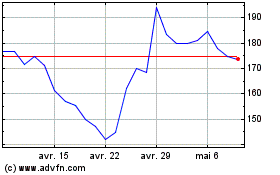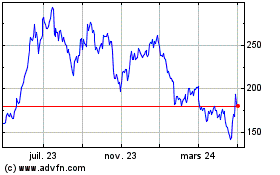By Ben Foldy
When it comes to the media display in your car, auto makers are
betting size does matter.
Car companies are introducing bigger screens -- and more of them
-- in their newest models. Executives say the larger displays are
needed as the systems that show navigational tools, music options
and the like become more sophisticated, and consumers -- especially
younger ones -- want to bring more of their digital lives into the
car.
The increased size and functionality, however, have raised
questions about whether outsize displays help or hinder efforts to
curb distracted driving.
Last week, at the Los Angeles Auto Show, Ford Motor Co. was the
latest auto maker to debut a mammoth display: a 15.5-inch touch
screen that will be in the company's new all-electric Mustang
Mach-E SUV when it goes on sale late next year. At that size, it
will be the industry's second largest in-car display screen behind
the 17-inch panel that Tesla Inc. introduced in 2012 on the Model S
sedan.
"The experience that our customers are familiar with on their
laptop or cellphone -- that rich experience -- has really moved
into the vehicle," said Gary Jablonski, chief engineer of connected
car technology at Ford.
Others such as Fiat Chrysler Automobiles NV, Toyota Motor
Corp.'s Lexus division and BMW AG have rolled out models recently
with display screens measuring 12 inches diagonally or more, larger
than the screen on the most popular iPad, which measures 10.2
inches.
The newest Ram trucks from Fiat Chrysler, for example, have a
12-inch touch screen display. Subaru Corp. recently introduced a
new Outback wagon and Impreza sedan with 11.6-inch displays, a size
available on all but the base models.
The number of vehicles built in North America with display
screens measuring 7 inches or more has grown by nearly 75% in the
past five years, to 10.9 million from 6.3 million, according to
data and analytics firm IHS Markit. The average size of the screen
also has increased, to 7.3 inches from 6.4 inches, during that
period, the firm's data shows.
"The trend we see in the industry is bigger is better," said
Georges Massing, an executive at Daimler AG's Mercedes-Benz
division who leads its digital vehicle technologies efforts.
Mercedes's newest multimedia system, the MBUX, combines a large
touch screen, measuring up to 12.3 inches on some models, with a
similar-sized display for gauges that spans roughly half the
dashboard. Drivers can call up features by tapping and swiping
items on the touch screen or using the system's voice-activated
digital assistant.
Byton, a Chinese electric vehicle startup, is taking screen size
to the extreme when it rolls out its first new vehicle, the M-Byte,
next year in China with a 48-inch display that stretches across the
entire span of the dashboard. The company said it plans to bring
the car to the U.S. in 2021.
Jeff Chung, Byton's vice president for digital engineering, said
its research has shown that drivers divert their gaze less from the
road with a supersize display, compared with one located in the
center console.
"Distraction comes when you can't find the information you
want," Mr. Chung said. He added, "It's not about the size of the
display but about the content and where that content is
located."
Already, drivers are struggling to stay focused with an influx
of new technology coming into the car and large displays only add
to the cognitive load, said David Strayer, a University of Utah
professor who studies in-car technology.
"As the screens get bigger, they also tend to inherit more
functions and features," Mr. Strayer said.
The wider use of touch screens is also worrisome because they
tend to replace the more familiar buttons and knobs, and can be
distracting for drivers, who often have to navigate functions by
tapping through different menus, said Jake Nelson, a traffic safety
and advocacy director at AAA.
Some car shoppers aren't impressed with the larger screens. Gino
Sferra, who is in the market for an SUV, said he hopes vehicle
safety systems are also improving.
"I don't think of my car as a place to be entertained," said Mr.
Sferra, a 32-year-old technology consultant in San Antonio.
Federal regulators have placed few limits on in-car displays and
what they can do.
The National Highway Traffic Safety Administration in 2013
issued a set of voluntary guidelines to cut down on distractions
from in-car displays, including recommendations on preventing
drivers from inputting text while the car is moving and against
displaying unnecessary images. The guidelines don't include
recommendations on size.
A NHTSA spokesman said the agency is testing how companies
comply with the guidance and will update it as needed, he said.
"The issue is that this is such a fast-moving technology, it's
hard for regulation to keep up with that," said Jake Fisher,
director of auto testing at Consumer Reports.
Industry designers say they are attentive to safety concerns.
Bigger displays allow for larger text and icons, they say, making
it easier for drivers to process information or quickly accomplish
their tasks. Whether a screen is distracting or helpful is less a
question of size than of how intuitive it is to use, Ford's Mr.
Jablonski said.
"You can do a big screen well or you can do a big screen
poorly," Mr. Jablonski said. "And we obviously think we're doing it
well."
Write to Ben Foldy at Ben.Foldy@wsj.com
(END) Dow Jones Newswires
November 25, 2019 05:44 ET (10:44 GMT)
Copyright (c) 2019 Dow Jones & Company, Inc.
Tesla (NASDAQ:TSLA)
Graphique Historique de l'Action
De Mar 2024 à Avr 2024

Tesla (NASDAQ:TSLA)
Graphique Historique de l'Action
De Avr 2023 à Avr 2024
